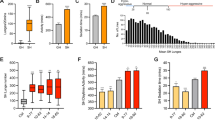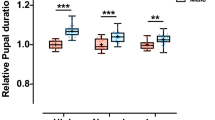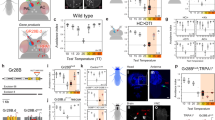Abstract
THE first temperature-sensitive paralytic mutant of Drosophila melanogaster, parat s, was isolated four years ago1–3. The mutation was mapped as a point at 53.9 on the X chromosome4. The present day stock of parat s moves normally at 22° C, but is paralysed within 10 s at 29.5° C. Paralysis is usually complete. The legs are held close to the body causing the fly to lie on its back or side. When returned to 22° C the fly recovers its mobility within 5 s. A much slower and less complete recovery occurs when the flies are left at 29.5° C (ref. 4). Only after 30 min are they able to walk and after 2 h a few flies can be induced to fly by shaking their container. The mutation has been shown to act in a regionally autonomous fashion within the head and thorax5.
This is a preview of subscription content, access via your institution
Access options
Subscribe to this journal
Receive 51 print issues and online access
$199.00 per year
only $3.90 per issue
Buy this article
- Purchase on Springer Link
- Instant access to full article PDF
Prices may be subject to local taxes which are calculated during checkout
Similar content being viewed by others
References
Williamson, R., Grigliatti, T., and Suzuki, D. T., Can. J. Genet. Cytol., 12, 400–401 (1970).
Grigliatti, T., Williamson, R., and Suzuki, D. T., Genetics, 64, s27 (1970).
Williamson, R., Drosoph. Inf. Serv., 46, 148–149 (1971).
Suzuki, D. T., Grigliatti, T., and Williamson, R., Proc. natn. Acad. Sci. U.S.A., 68, 890–893 (1971).
Grigliatti, T., Suzuki, D. T., and Williamson, R., Devl Biol., 28, 352–371 (1972).
Kaplan, W. D., and Trout, W. E., Genetics, 61, 399–409 (1969).
Kaplan, W. D., in Biology of Behaviour, (edit. by Kiger, J. A.) (Oregon State College 32nd Annual Biology Colloquium, Oregon State University Press, 1972).
Kaplan, W. D., and Trout, W. E., Genetics, 77, 721–739 (1974).
Lindsley, D. L., and Grell, E. H., Genetic Variations of Drosophila melanogaster, (Carnegie Institution of Washington Publication No. 627, 1968).
Pak, W. L., Grossfield, J., and Arnold, K. S., Nature, 227, 518–520 (1970).
Siddiqi, O., and Benzer, S., Annual Report, Division of Biology, California Institute of Technology (1972).
Hengstenberg, R., and Götz, K. G., Kybernetik, 3, 276–285 (1967).
Takeuchi, A., and Takeuchi, N., J. Physiol., Lond., 205, 377–391 (1969).
Usherwood, P. N. R., and Grundfest, H., J. Neurophysiol., 28, 497–518 (1965).
Pitman, R. M., and Kerkut, G. A., Comp. gen. Pharmac., 1, 221–230 (1970).
Fox, P. M., and Larsen, J. R., J. Insect Physiol., 18, 439–457 (1972).
Freeman, A. R., J. Neurobiol., 4, 567–582 (1973).
Trout, W. E., Drosoph. Inf. Serv., 44, 131 (1969).
Ephrussi, B., and Beadle, G. W., Am. Nat., 70, 218–225 (1936).
Bennet, J., and Hughes, J. F., Drosoph. Inf. Serv., 47, 74 (1971).
Author information
Authors and Affiliations
Rights and permissions
About this article
Cite this article
WILLIAMSON, R., KAPLAN, W. & DAGAN, D. A fly's leap from paralysis. Nature 252, 224–226 (1974). https://doi.org/10.1038/252224a0
Received:
Revised:
Issue Date:
DOI: https://doi.org/10.1038/252224a0
This article is cited by
-
Remembering Obaid Siddiqi, a pioneer in the study of temperature-sensitive paralytic mutants in Drosophila
Journal of Biosciences (2014)
-
Drosophila neural pathways
Journal of Comparative Physiology A (1985)
-
Electrophysiological analysis of the temperature-sensitive paralyticDrosophila mutant,para ts
Journal of Comparative Physiology ? A (1981)
-
New technique for movement analysis: Application to biological systems
Experientia (1977)
Comments
By submitting a comment you agree to abide by our Terms and Community Guidelines. If you find something abusive or that does not comply with our terms or guidelines please flag it as inappropriate.



